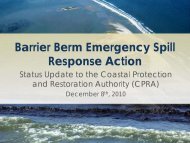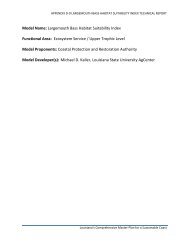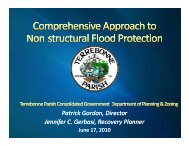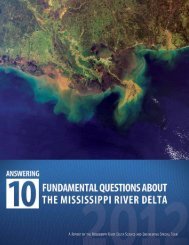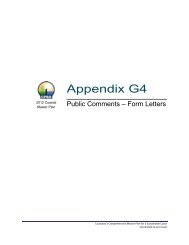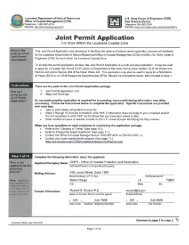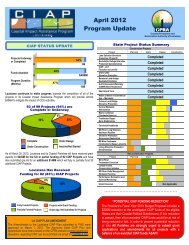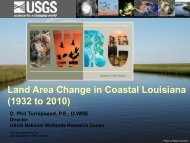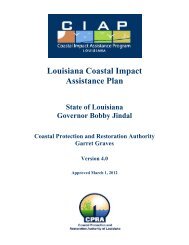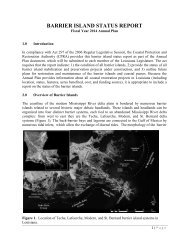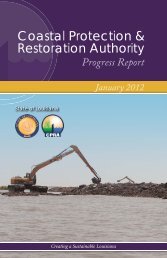Appendix G5a â Public Comments - Coastal Protection and ...
Appendix G5a â Public Comments - Coastal Protection and ...
Appendix G5a â Public Comments - Coastal Protection and ...
Create successful ePaper yourself
Turn your PDF publications into a flip-book with our unique Google optimized e-Paper software.
Thank you for the opportunity to comment on the State of Louisiana’s 2012-2017 Comprehensive MasterPlan for a Sustainable Coast (the “Master Plan”). The following comments are submitted on behalf ofCanal Barge Company, Inc.BackgroundCanal Barge Company, Inc. (“CBC”) is one of the largest privately owned inl<strong>and</strong> marine transportationcompanies in the United States, employing 32 towing vessels <strong>and</strong> over 850 barges in the Inl<strong>and</strong>Waterways <strong>and</strong> the Gulf of Mexico. Our area of operations stretches from Brownsville, TX to Pittsburgh,PA, <strong>and</strong> CBC employes over 580 personnel across 20 states.CBC is a family-owned business headquartered in New Orleans, Louisiana. Our executive team is activein both national <strong>and</strong> regional efforts to develop a systematic approach to water management; bothPresident/CEO Merritt Lane <strong>and</strong> Vice President – Risk Management Spencer Murphy were members ofthe Master Plan’s Framework Development Team (“FDT”) <strong>and</strong> Spencer Murphy also participated in theNavigation Focus Group. Our presence in New Orleans means we underst<strong>and</strong> the need for coastalrestoration <strong>and</strong> flood protection in order to protect our Gulf Coast communities; our presence across ournation’s waterways means we underst<strong>and</strong> the importance of navigation to our regional <strong>and</strong> nationaleconomy. We support efforts for coastal restoration <strong>and</strong> flood protection that can co-exist with <strong>and</strong> evenbolster our nation’s vital marine highways, <strong>and</strong> as further described below, CBC sees the Master Plan asan important step forward in those efforts.Marine HighwaysThe Master Plan has the potential to impact two of our nation’s most important commercial waterways:the Mississippi River <strong>and</strong> the Gulf Intracoastal Waterway (“GIWW”). According to the State ofLouisiana, over 450 million tons of waterborne commerce (20% of the nation’s total) travels throughLouisiana each year on these waterways. The Mississippi River is one of the key economic engines ofour nation <strong>and</strong> provides the most efficient means for American farmers <strong>and</strong> manufacturers to get theirgoods to market. For example, over 60% of our country’s grain exports move through Louisiana on theMississippi River.Less well known than the Mississippi, but equally important, the GIWW is the nation’s third busiestwaterway – only the Mississippi River <strong>and</strong> Ohio River carry more goods each year than the GIWW. TheGIWW is a 1300 mile system of channels <strong>and</strong> tributaries that runs from Brownsville, TX to St. Mark’s,FL <strong>and</strong> connects the Gulf Coast to the Mississippi River. It provides a vital link between the Gulf Coast’spetrochemical refineries <strong>and</strong> the rest of our nation, <strong>and</strong> directly <strong>and</strong> indirectly supports tens of thous<strong>and</strong>sof jobs.What makes navigation particularly relevant to the State is that the maritime industry provides one out ofevery 8 jobs in Louisiana (as found in a study by Dr. Tim Ryan of University of New Orleans), <strong>and</strong>further, water transport is by far the most fuel efficient <strong>and</strong> environmentally friendly mode oftransportation. A 2009 study by the Texas Transportation Institute found that relative to truck or rail,barge transportation:



